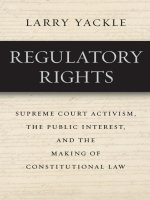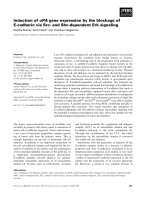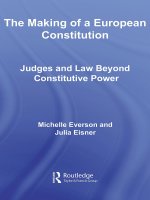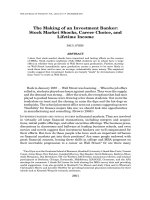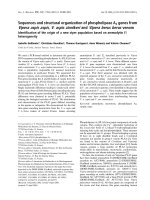The Making of a European Constitution Judges and Law Beyond Constitutive Power docx
Bạn đang xem bản rút gọn của tài liệu. Xem và tải ngay bản đầy đủ của tài liệu tại đây (1.53 MB, 257 trang )
The Making of a European
Constitution
Judges and Law Beyond Constitutive
Power
Not only addressing European constitutional jurisprudence, but also the
strategies and philosophies that judges and lawyers bring to bear when cre-
ating it, The Making of a European Constitution investigates and promotes
the sustainability of a theory or praxis of ‘procedural’ constitutionalism.
Building upon European and American critical legal scholarship,
Michelle Everson and Julia Eisner argue that constitutional adjudication
has never been a neutral matter of mere judicial ‘identification’ of the val-
ues, norms and procedures that each society seeks to concretise in its own
body of constitutional law. Instead, a ‘mythology’ of comprehensive national
constitutional settlement has obscured the primary legal constitutional
conundrum that is created by the requirement that a judiciary must always
adapt its constitutional jurisprudence to the evolving values that are to be
found within any society; but must, at the same time, maintain the integrity
and autonomy of the law itself.
European judges and lawyers, having been denied recourse to all forms
of constitutional mythology, provide us with an alternative model of con-
stitutionalism; one that does not require a founding myth of constitutional
settlement, and one which both secures the autonomy of law, as well as
ensures dialogue between law and society. This occurs, however, not
through grand theories of ‘constitutional adjudication’ but rather, as The
Making of a European Constitution documents, through practical process.
Michelle Everson is Professor of Law at Birkbeck College University of
London.
Julia Eisner has worked extensively as an academic assistant, specialising in
empirical, interview-based research.
The Making of a European
Constitution
Judges and Law Beyond Constitutive Power
Michelle Everson and Julia Eisner
First published 2007
by Routledge-Cavendish
2 Park Square, Milton Park, Abingdon, OX14 4RN, UK
Simultaneously published in the USA and Canada
by Routledge-Cavendish
270 Madison Avenue, New York, NY 10016
A Glasshouse book
Routledge-Cavendish is an imprint of the Taylor & Francis Group, an informa
business
© 2007 Michelle Everson and Julia Eisner
All rights reserved. No part of this book may be reprinted or reproduced or
utilized in any form or by any electronic, mechanical, or other means, now
known or hereafter invented, including photocopying and recording, or in
any information storage or retrieval system, without permission in writing
from the publishers.
British Library Cataloguing in Publication Data
A catalogue record for this book is available from the British Library
Library of Congress Cataloging in Publication Data
Everson, Michelle.
The making of a European Constitution : judges and law beyond
constitutive power / Michelle Everson and Julia Eisner.
p.cm.
ISBN 978-0-415-43905-3 (hardback : alk. paper) – ISBN 978-0-203-
93980-2 (e-book) 1. Constitutional law–European Union countries.
2. European Union. I. Eisner, Julia. II.Title.
KJE4445.E98 2007
342.24–dc22
2007008686
ISBN 10 (hb): 0-415-43905-1
ISBN 13 (hb): 978-0-415-43905-3
ISBN 10 (e-book): 0-203-93980-8
ISBN 13 (e-book): 978-0-203-93980-2
This edition published in the Taylor & Francis e-Library, 2007.
“To purchase your own copy of this or any of Taylor & Francis or Routledge’s
collection of thousands of eBooks please go to www.eBookstore.tandf.co.uk.”
ISBN 0 203 93980 8 Master e-book ISBN
-
-
-
Contents
Acknowledgements ix
Table of cases x
Introduction : The transfigured constitution 1
I. The failure of the constitutional moment 1
II. The power of law beyond the constitutional moment 2
III. Law in the making of the European constitution 4
IV. Seeing into the mind of European law 6
V. From constitutional to legal theory 8
VI. The transfigured constitution: a force for legal and
social good? 10
1 Constitutional mo(u)rning 13
I. The constitution is dead 13
II. The constitution is dead; long live the constitution! 14
III. ‘Bringing the law back in’: from constitutional theory
to legal and social theory 19
IV. Rechtsverfassungsrecht: between facts and norms in
European constitutionalism 22
V. Bringing politics back in: liberal deliberation and the
limits to democracy 26
VI. Constitutional morphogenesis 30
VII. Bringing politics back in: an ‘illiberal’ conclusion 32
2 Retelling the legal integration story 41
I. Introduction: law’s proprium and the inadequacy
of interdisciplinarity 41
II. The court and its academic interlocutors 44
III. The market and the law: an unforeseen and accidental
constitutionalism and its legal challenges 48
III.1. The market created: an act of formalist constitution 50
III.2. The market evolving: from ‘transcendental nonsense’
to economic rationality and back again 55
IV. The limits to market integration: constituting society
beyond the market 63
IV.1. The limits to corporatist dissolution: constraining
the self-defining European polity within the
European market 64
IV.2. The limits to organic interconnection: adjudicating
at the interface between Europe’s laws 68
IV.3. Law’s limits in the evolving political community 71
V. Between norm and fact: reflexive law and constitutional
morphogenesis 73
3 Forgetting law 85
I. Law and non-law in the convention process 85
II. Law and non-law in the constitution-building process 88
III. The reference procedure and the making of the
European constitution 94
IV. Judges, lawyers and the source of the force of law 97
IV.1. Data-set and methodology 98
4 Adjudicating non-authoritative law 104
I. Lawyers, (self-) illusion and the making of the
constitution 104
II. The formalist narrative of European constitution-building 105
III. Argumentation, evidence, problem-solving and strains
in the formalist narrative 109
III.1. Judicial dialogue: the basis for normative
re-alignment? 111
III.2. Legal language and constitution-building 112
III.3. Evidence and constitution-building 115
III.4. ‘Workability’ and constitution-building 116
IV. Servants to or agents of the constitution-building process? 117
V. Thick law: from adjudication to constitution-building 119
5 Constitutionalising the institutional balance of powers 125
I. Institutional balance within the European polity 125
II. Dynamic politics and static law: the high stakes of
judicial interventionism 129
vi Contents
II.1. Static adjudication 129
II.2. Transcendental nonsense and constitutional
adjudication 134
III. Polity-building within the institutional balance:
conflicts and consequences 140
III.1. The separation of powers versus the balance
of powers 141
III.2. Conflict, contradiction and the separation
of powers 144
III.3. The political, administrative and constitutional
functions of the institutional balance 148
III.4. The separation of powers versus the balance of
powers versus the rule of law 149
IV. Conclusion: invitatio ad offerendum and the principled
mechanics of constitutional morphogenesis 150
6 The principled judicial mechanics of constitutional
morphogenesis 157
I. The abyss beckons 157
II. Law and non-law: normative vision, political contention
and legal principle within the institutional balance? 163
III. Principles and (self-) illusion within European
constitutionalism 169
IV. Reconstructing social and political reality: legal (self-)
illusion unveiled 173
IV.1. Science, facts, explanation and legal reconstruction
of reality 174
IV.2. Law and political reality: democratic
experimentalism 178
IV.3. Professionalism, formalism and legal (self-) illusion
re-established 189
V. Conclusion: dynamic proceduralism 190
7 Constitutionalism beyond constitutions 200
I. An eternity of axiom 200
II. Europe’s law beyond axiom 204
II.1. Axiom refined: a final constitutional
settlement 204
II.2. The ‘free’ European legal movement 207
II.3. Europe’s reflexive legal order 211
III. Europe’s Rechtsverfassungsrecht 214
III.1. European legal formalism revisited 216
Contents vii
III.2. The real-world of European adjudication 218
III.3. Revolution, politics and deliberation 220
IV. The constitutional imperative 224
Bibliography 232
Index 241
viii Contents
Acknowledgements
This book was completed within the ambit of the fifth framework project
on Citizenship and Democratic Legitimacy in the European Union (CIDEL),
funded by the European Commission and co-ordinated by the Centre for
European Studies at the University of Oslo (ARENA). We are grateful to the
Commission for financing, which allowed us to conduct empirical research.
We are also indebted to all colleagues within CIDEL, and especially at
ARENA, for their academic support and insightful critiques and commen-
taries. In particular, thanks are due to Erik Oddvar Eriksen, John Erik
Fossum and Christian Joerges. In addition, we are also indebted to Chris
Engert for editing that went far beyond the call of duty.
Table of cases
Albany, Drijvende, Bokken and Bretjens [1999] ECR I-6025 and
[1999] ECR I-6121 (Joined Cases C-115/97, C-116/97,
C-117/97, C-219/97) 67, 83n52
Alpharma – Alpharma Inc. v Council of the European Union [2002]
ECR II-3495 (Case T-70/99) 148, 152n5
Azores – Regia
˘
o atonóma dos Açores v Council of the European Union
[2004] ECR II-2153 (Case T-37/04) 137–139, 148,153n22,
189, 198n58, 199n62
Bosman – Union royale belge des sociétés de football association ASBL v
Jean-Marc Bosman, Royal club Liégeois SA v Jean-Marc Bosman and
others and Union des associations européennes de football (UEFA) v
Jean-Marc Bosman [1995] ECR 1-4921 (Case C-415/93) 154n34
Brunner – Manfred Brunner v European Union Treaty [1994] 1
CMLR 971 38m50, 68, 71, 103n24, 141–142, 151, 155n40,
183, 220
Calpak – Calpak SpA v Commission [1980] ECR 1949 (Joined Cases
C-789/79 and 790/79) 155n48
Cassis de Dijon [1979] ECR 649 (Case 120/78) 58
Comitology – European Parliament v Council [1988] ECR 5615
(Case 302/87) 84n61, 132–134, 137, 153n9, 155n47, 177,
198n51
Commission of the European Communities v Council of the
European Union [2003] [2004] ECR 1-4829
(Case C-338/01), 153nn9, 21, 154n27, 156n52
Commission of the European Communities v European Parliament
and Council of the European Union [2003] ECR I-973
(Case C-378/00) 153nn9, 21, 156n52
Commission v Germany [1987] ECR 1227 (Case 178/84) 81n34
Cordoniu SA – Cordoniu SA v Council [1994] ECR I-1853
(Case C-309/89) 155n48
Costa v ENEL [1964] ECR 585 (Case 6/64) 49–51, 78n17,
79n25, 102n23
Dassonville – Procureur du Roi v Dassonville [1974] ECR 837
(Case 8/74) 58
European Parliament v E.U. Council [1996] 1 CMLR 4
(Case 65/93) 153n24
Extramet Industrie SA – Extramet Industrie SA v Council [1991]
ECR I-2501 (Case C-358/89) 155n48
Factortame – R. v Secretary of State for Transport, ex parte Factortame
Ltd (No.4) [1996] 2 WLR 506 (HL); ECR I-1029, ECJ
(Case 48/93) 104–105, 113, 122n2
Federation Nationale d’Agriculture Biologique des Region de France
and Others v Council of the European Union [2001] ECR I-3811
(Case C-345/00), 153n20
Industrie- en Handelssonderneming Vreugdebhil v EC Commission
[1994] 2 CMLR 803 (Case C-282/90) 154n26
Keck – Criminal proceedings against Keck & Mithouard [1993]
ECR I 1-6097 (Cases 267/2 – 68/91) 58, 82n46, 103n24
Les Vertes – Parti écologiste Les Vertes v European Parliament [1986]
ECR 1339 (Case 294/83) 72–73, 84n61
Lochner v New York 198 U.S. 45 S Ct, 49 L. Ed. 937 (1905) 229n10
Meroni – Meroni v High Authority of the European Coal and Steel
Community. [1958 ] ECR 133 (Case 9/56) 129–131, 136, 153n12
Muller v Oregon and the Brandeis Brief 208 U.S. 412 (1908) 81n35
Parfums Christian Dior SA – Parfums Christian Dior SA v TUK
Consultancy BV and Assco Geruste GmbH and Rob van Dijk v
Wilhelm Layher GmbH & Co. KG and Layher BV [2002]
ECR1-11307 (Case 300/98) 154n28, 156n53
Pavel Pavlov [2000] ECR I-6451 (Joined Cases C-180/98 to
C-184/98) 83nn52, 54
Pfizer – Pfizer Animal Health SA v Council of the European Union
[2002] ECR II-3305 (Case T-13/99) 81n37, 123n16, 148,
152n5, 189, 199n62
Phillip Morris Inc – Phillip Morris International, Inc. and Others v
Commission of the European Communities [2003] ECR 1
(Case T-377/00) 147, 153nn10, 19, 154n26, 198n59
Plaumann – Plaumann & Co v Commission [1963] ECR 95 (Case
C-25/62) 155n48
Poucet and Pistre [1993] ECR I-637 (Joined Cases C-159/91 and
C-160/91) 83nn52, 54
Re Radioactive food – European Parliament v Council [1990] ECR
I-2041 (Case 70/88) 84n61, 132, 134, 138, 153nn9, 18
Re Tax on Malt Barley [1964] CMLR 130 FG (Rheinland-Pfalz),
(Case-III 77/64) 129, 183, 198n45
Re the Budget – Council of the European Communities v European
Parliament [1986] 3 CMLR 94 (Case-34/86) 138–139, 156n51
Table of cases xi
Re: Generalised Tariff Preferences – European Parliament v EU Council
[1995] 1 CMLR 4 (Case C-65/93) 131, 153n25
Society for the Protection of Unborn Children v Grogan [1991]
ECR I-4685 (Case 159/90) 82n46
Star Fruit – Star Fruit v Commission [1989] ECR 291
(Case C-247/87). 155n49
Stichting Greenpeace – Stichting Greenpeace v Commission [1995]
ECR II-2205 (Case C-321/95) 155n48
Stoke-on-Trent and Norwich City Councils v B & Q plc [1992]
ECR I-6635 (Case 169/91) 82n45
Torfaen Borough Council v B & Q plc [1989] ECR 385
(Case 145/88) 82n45
van Gend & Loos – van Gend & Loos v Netherlands Inland revenue
Association, [1963] ECR 105 (Case 26/62) 48, 50, 54, 78n17,
79n25, 102n23, 169, 197n36
Verband der Sachversicherer – Verband der Sachversicherer e.V. v
Commission of the European Communities ECR [1987] 405
(Case 45/85) 56
xii Table of cases
Introduction
The transfigured constitution
I. The failure of the constitutional moment
The course of constitution-making within Europe has never run less smoothly.
At the time of writing, French and Dutch electorates have inflicted a brutal
blow upon the aspirations of European sentimentalists everywhere, rejecting
the adoption of the draft constitutional treaty for Europe. As a consequence,
the putative ‘European Constitution’ – so carefully drawn up by the European
Constitutional Convention and so firmly approved by an Intergovernmental
Conference – now languishes in limbo, a seemingly unloved and unlovable
document, and simple testament to the failure of European parliamentarians
and governments to force a true constitutive moment within Europe.
Why did this happen? What caused the peoples of Europe to reject such
a carefully prepared appeal to their constitutional instincts? The answer to
this question is especially revealing: popular rejection of the draft treaty
cannot be traced to a single source of public discomfiture with or about the
specific aims of European integration. Instead, voices of constitutional dissent
are clearly discordant with one another, as well as with the current process of
European integration as a whole, indicating that the lack of agreement about
the future European telos is not, simply, a temporary check on integrationist
ambitions, but, rather, a pathological feature of European politics.
At the level of the identification of a joint political will to create or
entrench Europe as a ‘Union’, the death-knell has been sounded for constitu-
tional aspirations. A European polity does not exist. For all of the European
Convention’s efforts to forge a common European desire for and interest in
‘closer European union’, the publics of Europe remain inexorably divided,
not simply along national, but, vitally, also along ideological lines. For
every ‘European federalist’, who is possessed of a firm will to join within a
European political community, we can also identify a malcontent, to whom
the notion of a constituted Europe is anathema, either since he or she possesses
a preference for the maintenance of national community, or, importantly,
since he or she has already committed him/herself far beyond the European
ideal, in order to embrace more globally conceived conceptions of community.
In terms of traditional constitutional theory, such overwhelming discord
and disjunction amongst Europeans amounts to one highly uncomfortable
fact: the political effort to create a European constitution has been compre-
hensively frustrated. It has ground to a standstill because European publics
have failed to join together as a constitutive power, or constituent pouvoir,
with a common will powerful enough to endorse the efforts of a European
Convention to draft a constitutional text of enduring ideological and gov-
erning power. Further, the brave, if perhaps naïve, endeavour of European
elites to open up the process of the concretisation of the governing institu-
tions of the EU to review and endorsement by the peoples of Europe has
backfired in a historically significant manner. It has intensified rather than
overcome division and discord amongst individual Europeans, thus retard-
ing the establishment of the unitary European political community from
which a clear and common constitutive power might be derived. If the making
of a European constitution is primarily a matter of an inspirational politi-
cal process, whereby individual Europeans come or are brought together to
identify and to endorse the shared set of common and entrenched values
that will create and guide the institutions of European governance, then our
European Union must surely remain without a constitutional text for the
foreseeable future.
II. The power of law beyond the constitutional moment
Yet, the failure of the constitutional convention process is also far from
being the end of the European constitutional story. More particularly, and
with a specific eye to the evolution of the European legal order, the European
Constitutional Convention and the International Governmental Conference
(IGC) on the draft constitutional treaty might be argued to appear less in
the guise of momentous, if counterproductive, attempts to force the pace of
political constitution-making within Europe, and more in the character of
momentary distractions from the real-world and nitty-gritty business of the
judicial establishment and elaboration of a specific form of constitutional-
ism for Europe. Speaking historically, processes of European integration have
often been driven by law, rather than politics, such that one former Advocate
General of the European Court of Justice (ECJ), when interviewed for this
volume, might comfortably assert the utter irrelevance of the convention
process:
If the French or the British or whoever it is, or the Dutch, are voting
against it, that’s not a disaster for me. More important for me is con-
stitutionalism. And we have constitutionalism.
‘Constitutionalism’, a legal process of the extrapolation of the values and
institutions, which will determine the course of our joint European life,
2 The making of a European constitution
proceeds apace, untroubled by all failed political efforts to establish a
European polity. To this exact extent, then, the unexpected strength of pub-
lic frustration with the draft treaty, as well as glee at the failure of the
Constitutional Convention and ralification process, might be readily
explained. Not only were Europe’s self-nominating governing elite assum-
ing a politically constitutive mantle for a public who felt, by stark contrast,
that their popular sentiments had been subverted rather than represented;
instead, they were also doing so in an on-going context of European inte-
gration, within which a supranational European legal order had already
long set about creating the long-term values and institutions that characterise
Europe, imposing them upon a European public without any thought for
popular legitimation.
For European lawyers at least, negative popular referenda in Holland and
in France have had little impact upon a daily legal task of giving life to a
European constitution. European lawyers confidently declared that Europe
was (in part at least) already in possession of a European constitution as
early as the 1980s. Increasingly, national lawyers overwhelmingly concur.
The European legal order already constitutes a constitutional framework,
within which the ECJ, with its seat in Luxembourg, has consistently usurped
the traditional role of a constitutional court, and under which, national law
and national politics have slowly been subordinated to a ‘federal type struc-
ture’ that is governed by a ‘supreme’ European legal order.
In popular imagination, which has, perhaps, cast its eye over historical
instances of constitution-making, such a situation cannot but seem to be curi-
ous and alienating. Within the western tradition of popular self-determination,
constitutions, supreme courts and sovereign political communities (includ-
ing federal political communities) are generally established following tumul-
tuous political conflict, or even revolutions – whether glorious, bloodthirsty
or velvet in nature – at the conclusion of which, ‘we, the people’ join
together to establish common goals and values, and to direct institutions of
government, including the law, in pursuit of those aims. The Philadelphia
Convention, establishing the self-evident truths of the US Constitution, thus
still holds the power to capture and inspire the public mind, standing as a
beacon to the ability of a once-colonial populace to throw off the legal fet-
ters of an oppressive power and to furnish itself with a measure of national
self-determination.
Within the European setting, however, historical paths of constitution-
making would seem to have been reversed. Once-proud and self-determining
nations succumb to the progressive powers of legal edict. Lawyers and their
legal order furnish revolutionary impetus: swords and guns are put aside in
favour of the more muted, but equally effective, revolutionary fervour of
judicial and legal pronouncement. Europe’s law is supreme since its lawyers
have declared it to be so, and because national lawyers have acquiesced in such
pronouncements. ‘We, the peoples of Europe’, by contrast, are no longer the
The transfigured constitution 3
authors, but have instead become the passive subjects of a new and usurp-
ing European constitutional tradition.
Alienation is layered upon alienation. Europeans are not only disregarded
by their own political elites. Instead, they are also dictated to by their own
legal servants. This apparent fact gives rise to one overwhelming concern
about the legitimacy of current processes of constitution-making within the
European Union and, accordingly, furnishes a simple explanation for the
primary investigation undertaken within this book. The political effort to
impose a written constitutional document upon the peoples of Europe was,
perhaps, lacking in legitimacy: how could the national and European par-
liamentarians and bureaucrats gathered together within the European
Convention have simply usurped the constitutive prerogatives of European
peoples? Yet, this effort was also easily rebuffed: the peoples of Europe have
rejected the draft constitutional treaty. At the same time, however, the legal
process of constitution-making within Europe continues unabated, appar-
ently unchecked by negative public sentiment. Accordingly, vital questions
must now be posed to lawyers throughout Europe with a renewed urgency:
for whom are you making a constitution, where does your constitutive
authority derive from and how are you accountable or responsible to the
peoples who are the subjects of your constitution?
III. Law in the making of the European constitution
Both national and European lawyers play their important part in the creation
of a constitutional order within Europe. At national level, member state
judiciaries have allowed European law to encroach upon their own estab-
lished jurisdictions, often setting the political preferences of their member
state governments aside – and sometimes even uprooting age-old national
constitutional principles and traditions – all in the service of the strictures
and individual rights found within European law. At European level, the
ECJ has taken on a mythical character; its notoriety within legal history has
been resoundingly assured by its proven ability to transform a once-simple
order of international law – addressed to the member states and lacking in
immediate relevance for individual Europeans – into an all-pervasive fact of
European life, which can be relied upon by all European citizens, in order
to assert their European rights above politically legitimated national legis-
lation. Equally, however, the ECJ also plays a daily and vital role in the
shaping and the controlling of the character and relative governing powers
of European institutions, such as the European Parliament, European
Commission and Council.
Academic lawyers have evolved very many theories to explain and to justify
the unusual and unusually potent role that national and European lawyers
have played in entrenching the European legal order throughout the conti-
nent. Thus, to give only one example, it can be argued that the assertion of
4 The making of a European constitution
the dominance and legitimacy of the European legal order is always only
conditional in nature, since European law is derived from and, therefore,
dependent upon the constitutive power and approbation of national consti-
tutional orders for its existence. Equally, however, non-legal academics have
also sought to cast the apparent expansionism of the European legal order
in a less pejorative light. The European legal order is not in the business of
usurping (national and European) political competences. Instead, or so
European political science argues, European law is still subject to political
checks and guidance, because member state governments, or the ‘Masters
of the Treaties’, are always free to rein back, or even overturn, European
legal developments during the process of the revision of European treaties
(i.e., at IGCs).
However, powerful as such arguments may be in academic terms, they
are nonetheless also limited in one very important respect: founded either
in grand ideological schemes, which seek to explain how the European
Union as a whole is legitimated, or, alternatively, derived solely from the
internal grammar and logic of law and legal development, they fail to offer
non-lawyers a direct insight into the mind of the law. A telling question
remains unanswered: why should a European public trust in a European
constitutionalism, or the ability of European law to compensate for the lack
of a constitutional moment and to establish the values and institutions
which do and will dominate European life? In other words, if constitutions
are generally held to encapsulate the common values of the publics that they
serve, extra-legal opinion is surely entitled to ask how the lawyers, who are
creating a European constitution ‘outside’ conventional political process, sift
through a multitude of competing European ideologies, establish authoritative
constitutional values, and, subsequently, reconnect with the popular senti-
ments and aspirations that are prevalent within European society. The
European legal order, encompassing national and European law, is said to
be unique. Its emergence has challenged all our common preconceptions
about the nature of law within constituted societies. European law was not
created by the peoples of Europe; nor is it directly governed a European
political community. Seen in this light, the onus upon law and lawyers is
thus surely a heightened one of self-justification and extra-legal explana-
tion. Where do the values promulgated by a European legal order derive from?
Is Europe’s law a simple reflection of the personal opinions and prejudices
of Europe’s lawyers, or does it have its roots in a deeper form of legitima-
tion? Given the absence of a European constitution, how does Europe’s
‘ethereal’ or abstract law reconnect with the concerns, interests and values
of a European public?
This book seeks to answer these vital questions. More particularly, it
seeks to examine interconnections between judicial/legal pronouncement
and political processes of constitution-making, as well as the wider relation-
ships that are maintained between modern (post-national) law and modern
The transfigured constitution 5
(post-national) societies. In tackling these questions, however, the study also
diverges in its approach from many current academic analyses of constitution-
building within Europe. First, a lesser, tangential, emphasis is placed upon
the current political effort to furnish the EU with a constitution. Second,
re-locating the primary focus of analysis upon the role of law in constitu-
tional progress, the study is concerned less with grand interdisciplinary the-
ories, which seek to explain the whole of European integration, and more
with the identification of a legal narrative of constitution-building, which
focuses upon the establishment of the immediate ‘societal’ legitimacy of a
European legal order. Third, and as a direct consequence, the study also
departs from established approaches to the theorising of constitutional
development, arguing that the story of the emergence of a legally driven
constitution-building process within Europe cannot be usefully explained
with reference to entrenched frameworks of state and constitutional theory,
but must, instead, be analysed through the lenses of legal and social theory.
IV. Seeing into the mind of European law
‘Seeing into the mind of law and lawyers’ is not an easy task. In particular,
and as a part of its integral vocation to remain ‘apart’ from the society that
it serves, law is created by its own semantic and grammatical structure. The
necessary social impartiality of law – its ability to retain independence when
adjudicating between diverse and conflicting interests within a single society –
demands that law and lawyers pursue their own logics of legal development.
Accordingly, law is an ethereal and abstract construct, a transcendental
framework with its own veil of ‘formal’ legal reasoning, which both pro-
tects law from partisan embroilment within the competing values or
‘value irrationalism’ present within a non-legal environment, and safe-
guards a wider society, ensuring that lawyers remain true to the cause of
law, promoting its, rather their own personal, ethics and morality. At the
same time, however, law is also a part of society, a mechanism of social
interventionism and integration, which is beholden to extra-legal aims and
values and which has measurable impacts within a real-world of societal
organisation.
Law exists at the very heart of a contradiction. On the one hand, it is and
must preserve its status as an autonomous institution, set apart from the
real-world of social interaction. On the other hand, however, it is also a
social institution, having tangible relationships with and material impacts
upon an extra-legal environment. At the level of the effort to understand the
part that lawyers have played and continue to play within the making of a
European constitution, this contradictory status has a number of conse-
quences. First, and most importantly, the genesis of legal constitutional
development within Europe cannot simply be laid bare by doctrinal or
purely legal investigation of the case law and pronouncements of European
6 The making of a European constitution
and national courts. These are the simple external manifestations of internal
lawyerly dedication to a theology of legal evolution, which might only be
understood within its own transcendental terms. Instead, the self-referential
veil of legal reasoning can only be drawn aside, the real impetus for consti-
tutionally expansionist judicial decision-making only be teased out from
behind an established canon of legal self-justification, where judges and
lawyers are ejected from their courtrooms and law libraries. The underly-
ing justificatory narrative for the judicial and legal act of constitution-building
within Europe can only be found where law and lawyers are denied
recourse to traditional legal dogma, to be subject, instead, to carefully pre-
pared structural interrogation, which peels back the layers of formalist self-
illusion to slowly, if tentatively, reveal the true manner in which the law and
lawyers conceive of their relationship with a real-world.
To this end, this current study turns away from traditional doctrinal legal
analysis to instead embrace and deploy socio-legal methodologies that seek
to pry behind the façade of formal law, in order to identify the exact manner
in which lawyers and law engage with the facts of an extra-legal environ-
ment. How do lawyers and judges confront social facts? How do lawyers
and judges choose which non-legal interests, concerns or values to privilege
within a legal semantic? How, more importantly, do judges and lawyers seek
to reconcile extra-legal interests, concerns and values within a self-contained
body of abstract legal doctrine?
At the level of national law, structured interviews are accordingly con-
ducted with judges and lawyers of the High Court of England and Wales in
an effort to reveal the reasons why member state jurists have been so com-
plicit in the rolling back of national jurisdictions and have likewise played
their integral part within the acceptance of the supremacy of the European
legal order. Why have national judges dispensed with national self-interest?
Why have they allowed their constitutional orders, given constitutive power
by the individual peoples of Europe, to be encroached upon by a suprana-
tional legal order, which itself seems to have little or no constitutive authority?
The famous Article 234 EC ‘preliminary reference mechanism’ establishes
an interface between national and European legal orders. Why, at this
interface – establishing the exclusive right of the ECJ to rule on the meaning
of European law – have national judiciaries acquiesced in the process whereby
individual European legal right has been asserted above national political
community? Equally, however, at European level, complementary questions
can be and are posed. Taking a data-set made up primarily of former judges
of the ECJ, and focusing the analysis upon the pivotal European ‘constitu-
tional’ principle of ‘the balance of powers’, the effort is one of ascertaining
why European judges feel confident in asserting the constitutional authority
of European law. Which are the means that European judges deploy in order
to justify their readily apparent stance that European society has developed
to the degree that its lawyers can confidently declare the ever increasing
The transfigured constitution 7
breadth of their own jurisdiction? Equally, how does or can European law
justify decisions, apportioning prerogatives and competences within its own
jurisdiction; decisions that determine who, amongst a cacophony of com-
peting European and national institutions, governments and publics wields
the real power of decision within a European Union?
V. From constitutional to legal theory
This structural unveiling of constitutional legal narrative within Europe,
however, also has its theoretical consequences. The traditional division
that is made between political processes of constitution-building and legal
processes of constitutional adjudication is a powerful one. Law, we are
often reminded, has no part to play in the initial determination of the values
and institutions that will govern any given individual society. Instead, the
primary legal constitutional function is one of execution of the constitution
and its preservation in the face of any illegitimate assault by ‘constitution-
ally deviant’ political forces. First comes the constitution, then comes the
law: traditional constitutional theory accordingly focuses on the faithful-
ness or otherwise of a constitutional judiciary to a founding constitution, as
well as the means whereby such faithfulness can be assured. Which inter-
pretational rules should a constitutional judiciary apply in order to divine
the meaning of a constitution in any given context? How can we be sure
that judges and lawyers will not subvert the constitution to their own or
others’ political aims? These questions are asked in all constitutional juris-
dictions, and also find their echo within recent European constitutionalisa-
tion debates with, for example, the European Constitutional Convention
seeking to establish written constitutional guarantees for the professional
competence and independence of a European judiciary. The substance of
Europe’s politically conceived constitution, it seems, would most appropri-
ately be safeguarded by a professionally irreproachable and apolitical cadre
of European lawyers.
The independence and, above all, the professionalism of Europe’s lawyers
is also a factor within the following analysis. However, given the lack of a
founding (political) constitutive act within the EU, as well as an underlying
aim to unveil the thinking behind a legal process of European constitution-
building, this analysis cannot but step beyond constitutional theory in its
endeavours to examine the European legal order’s narratives of constitu-
tional self-justification. Constitutional theory can help us to understand
how lawyers treat a constitutive act, or a formal constitution. What it can-
not do, however, is explain how lawyers justify their own actions in substi-
tuting for the constitutive act and formal constitution. The political process
of constitution-building within European has failed; law continues to compen-
sate for that failure, ordering and mediating between diverse interests, values
and ideologies within a ‘federal-type’ constitutional framework. However,
8 The making of a European constitution
the legal act of ordering and mediation, and, above all, its legitimacy, can
only be revealed and tested within bodies of social and legal theory, which
investigate the far broader relationships that are established between law
and the extra-legal environment in which it is embedded.
Social and legal theory is thus concerned far less with intricate, if abstract,
questions of how law might identify and apply the values encapsulated within
constitutional norms, and far more with the fundamental, but nitty-gritty
question of how law maintains its own impartiality, or autonomous char-
acter, but, likewise, responds appropriately to a real-world and its very
immediate social and political demands. What is law’s proprium? Law,
so social and legal theory reminds us, is forever caught on the horns of a
dilemma. Law is not of this world, but is, instead, a transcendental force of
self-referential reasoning. At the same time, however, law’s underlying claim
to dispense of social, as well as legal, legitimacy determines that it must
engage with a world outside law, in order to bring its abstract formulations
into line with an actual realm of social and political contestation. The ‘consti-
tution’ might well claim its own pre-eminence above law, or, indeed, above
social and political process. Nonetheless, we are all aware that this pre-
eminence is constantly tested by far more immediate and tangible processes
of legal and social interaction, which, in their turn, cannot be legitimated
with simple recourse to the imagined norms of constitutional tradition.
As such, social and legal theory offers us a far greater opportunity to
assess the hidden narrative of legal constitution-building within Europe,
testing its legitimacy in the light of the ability of Europe’s legal system to
order and mediate effectively between the tangible, yet often conflicting,
interests and values of European publics. To return to our starting point:
political processes of constitution-building within Europe have failed pre-
cisely because European publics have been unable to identify and establish
a constitutive will, a common ideology, or set of shared values and an
agreed upon goal of integration, which might be used to direct the institu-
tions of European governance, including a European ‘constitutional law’.
Yet, Europe is a social and political reality, to which Europe’s legal order
does and – if we are not simply to dispense with the European experiment
or, alternatively, descend into meaningless political violence – must respond.
Europe presents us with a real-world of social and political integration.
Likewise, this is a real-world, which is characterised by the presence of very
many and very diverse political, social and economic values and interests.
Similarly, the European legal order exists and, with its founding roots
within national (liberal) constitutional traditions, exists precisely in order
to mediate conflict between interests and to give voice to ‘legitimate’ values.
Seen in this real-world light, the on-going process of legal constitution-
building within Europe might, accordingly, be considered less an assault
upon the value-laden integrity of European publics, and more the continuance
of a ‘civilising’ European tradition beyond national boundaries, whereby
The transfigured constitution 9
conflict is diffused and ‘just’ social organisation established with reference
to an authoritative framework of law. Yet, in order to make good this claim,
the legal process of constitution-building within Europe must likewise be
subject to probing investigation: taking a legal narrative of constitution-build-
ing as the focus for analysis, which are the mechanisms that ensure the
authority and legitimacy of a constitutional and constitutionalising European
legal order? Similarly, stripping the question down to more immediate
terms: given continuing deep-seated conflict on the meaning and value of
European integration, how can and do European lawyers mediate – daily
and authoritatively – between divergent social and political positions, decid-
ing which value or which interest will prevail in each concrete case before
them?
VI. The transfigured constitution: a force for legal
and social good?
The problems posed by European integration are not, perhaps, unique:
after all, and all equalising constitutional traditions apart, all societies con-
tinue to be marked by deep-seated conflict between the values espoused and
interests promoted by social actors. Accordingly, exacting study of the
mechanics of legal constitution-making within Europe gains in general sig-
nificance; not, however, since European law is sui generis in nature, but
rather since functionally imperative European processes have – uniquely –
denuded and stripped away all totalising constitutional myths to reveal,
instead, a real-world of inexorable societal contestation, as well as the true –
and very fragile – nature of the legal process that governs contestation.
The current degree of alienation felt by European publics towards a
European legal order that is no longer anchored within notions of service
to an established political community is wholly understandable. Nonetheless,
Europe’s law is not simply an alien force, responding to novel and unknown
problems of human governance. Instead, the European legal order has
grown out of national complexes of law and responds, at European level,
to social conflicts and problems of social organisation, which are also pres-
ent within member state societies. The oft-touted sui generis nature of Europe’s
law must, as a consequence, be cast in more carefully differentiated terms.
Certainly, the underlying legal narrative of constitution-building within
Europe contrasts starkly with traditional constitutional narratives with all
their appeals to elusive and illusionary notions of joint and indivisible
national community. Nonetheless, this narrative is also a generalised and
generalisable one, applicable to all modern societies, whether those societies
are national, post-national, supranational or international in nature. To the
extent that processes of European integration have simply stripped away all
myth and all illusionary narratives of constitutional and legal perfection to
reveal true social process, they have also revealed the true face of law, as
10 The making of a European constitution
well as its underlying and inspirational modern mission of structuring soci-
etal integration within a real, rather than imagined, world.
Public alienation in the face of a constitutional and constitutionalising
European legal order might, thus, also be considered misplaced. To the exact,
but only, degree that European law can furnish us with a narrative that jus-
tifies its constitutional and constitutionalising functions, it appears less in
the guise of a repressive and destructive instrument of ideological (federalist)
domination, and more in the character of a modern and responsive instru-
ment of societal governance. In the absence of abstract, pre-conceived schemes
of human governance, the legal order within Europe is forced to articulate
real-world schemes of legal legitimacy or self-justification. A revealed real-
world possesses its own tangible demands for ‘justice’. In order to establish
its own authority, legal narrative must accordingly both preserve its own
internal integrity, and be socially responsive. It must reply reflexively to the
conflicting political and social demands found within a realm of real, rather
than posited, social organisation, mediating between those demands with-
out, however, ever sacrificing its own legal impartiality. This modern legal task
is undoubtedly an onerous, possibly even an impossible one. Nonetheless,
where all totalising axioms and myths of social equalisation are stripped
away, and law is forced to face a reality of societal contestation – which, by
the same token, allows for the political articulation of social concerns and
values that are otherwise repressed and disregarded within governing (con-
stitutional) myths – legal acts of social ordering and mediation may also
take on a truly universal character that transcends, rather than destroys our
historical constitutional traditions.
Political efforts to force a constitutional moment within Europe have failed.
Yet, it is perhaps a blessing that they have done so. Our traditional (politi-
cally constituted) constitutions are undoubtedly flawed, being founded within
an inspirational but ultimately spurious universalism, which itself derives
from the illusionary notion that the concretisation of one set of social val-
ues and institutions can or does represent the whole of human nature. The
result is (sadly) the creation of a myth and a betrayal of real-world social
process; an exclusionary act, which denies the validity of emerging interests,
concerns and values that conflict with the revolutionary, but entrenched,
aims of the founding constitutive act. The true inspirational quality found
within messy, but realist, processes of European integration is one of trans-
figured universalism. Europe currently transcends the limitations of its mem-
ber states, with their national myths, national constitutions and national
laws. Founded within legal principles of (national) non-discrimination and
responding piecemeal to real-world functional demands, the European
Union has also escaped the confines of ideological pre-determination,
allowing a real-world of social and political organisation to continue to
articulate its real-world (sometimes yet-to-emerge) demands for social and
political justice. Seen in this light, the final and formal constituting of a closed
The transfigured constitution 11
European governing order would also be anathema to transfigured univer-
salist European ideals, an exclusionary reversal of the historical effort to
ensure that all may actually share within a joint European existence.
To the extent that legal processes of constitution-building within Europe
are also a part of a historical movement, which (though necessarily imper-
fect) has seen all European and national institutions of governance, as well as
European publics, implicated within the (largely accidental) effort to tran-
scend the limited and illusionary universalism of nation states and national
constitutional settlements, such processes should never be too readily dis-
missed as illegitimate and alienating legal acts. Instead, to the degree that
an underlying European legal narrative of constitution-building preserves
the integrity of law (legal autonomy and impartiality), facilitates the social
responsiveness of law (legal reflexivity) and, further, sustains and orders
societal contestation (legal universalism) within Europe, the constitutional
activities and aspirations of European judges and lawyers are not a part of
the end of the constitutional story. Instead, they are a blueprint for legal
process within the next chapter of the constitutional story; a constitutional
story which is now witness to the transfiguration of the notion of the con-
stitution. The Constitutional Convention may have failed in its political
efforts to constitute Europe. Nonetheless, European law may yet hold the
key to a brighter constitutional future.
12 The making of a European constitution
